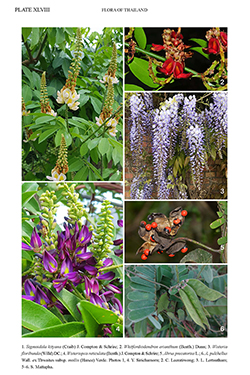e-Flora of Thailand
Volume 4 > Part 3 > Year 2020 > Page 483 > Leguminosae-Papilionoideae > Abrus
1. Abrus precatorius L.wfo-0000178702
Syst. Nat. ed. 12, 2: 472. 1767; Lour., Fl. Conchinch. 2: 428. 1790; DC., Prodr. 2: 381. 1825; Roxb., Fl. Ind. ed. 2: 258. 1832; Wight & Arn., Prodr. Fl. Ind. Orient. 1: 236. 1834; Blanco, Fl. Filip.: 565. 1837, ed. 2: 394. 1845; Miq., Fl. Ned. Ind. 1(1): 159. 1855; Thwaites, Enum. Pl. Zeyl.: 91. 1859; Baker in Oliv., Fl. Trop. Africa 2: 175. 1871 & in Hook.f., Fl. Brit. India 2: 175. 1876; Forbes & Hemsley, J. Linn. Soc. Bot. 23: 187. 1887; Trimen, Handb. Fl. Ceylon 2: 57. 1894; Merr., Philipp. J. Sci. 1, suppl.: 66. 1906 & Philipp. J. Sci., C 5(2): 108. 1910; Gagnep. in Lecomte, Fl. Indo-Chine 2(3): 357. 1916; Ridl., Fl. Malay Penins. 1: 558. 1922; Craib, Fl. Siam. 1(3): 434. 1928; Breteler, Blumea 10(2): 617, f. 5. 1960; Verdc., Kew Bull. 24: 240. 1970; T.C.Huang & H.Ohashi in H.L.Li et al., Fl. Taiwan 3: 394, pl. 505. 1977; Rudd in Dassanayake & Fosberg, Revis. Handb. Fl. Ceylon 1: 446. 1980; Lock & Heald, Legumes Indo-China: 49. 1994; Bojian & Gilbert in Z.Y.Wu et al., Fl. China 10: 194. 2010; Munsuk et al., Trop. Nat. Hist. 16(2): 68. 2016. Plate XLVIII: 5.
Accepted Name : This is currently accepted.
Synonyms & Citations :
Description : Perennial climber; young stems puberulent or glabrescent. Stipules free, lanceolate, 3–5 mm long, white hairs, caducous. Leaves with petiole 1–1.8 cm long, hairy; leaflets 28–32 (14–16-jugate); lamina oblong or rarely obovate, 14–25 by 5–8 mm, apex obtuse or mucronate, base obtuse, oblique or cuneate, margin entire, usually lower surface with puberulose hairs or rarely in upper surface. Inflorescences 10–11 cm long; bracts deltoid, minute, caducous; bracteoles suborbicular, ca 1 mm diam. Flowers 9–12 mm long. Calyx sparsely pubescent; tube 2–3 mm long; lobes ca 1 mm long. Corolla pinkish to purplish or white, glabrous; standard with stipe, ovate, 10–12 by 6–7 mm, apex obtuse; wings with stipe, linear, 12–15 by 2–3 mm, base auriculate; keel with stipe, 11–12 by 3–4 mm. Stamens: filaments 0.8–1 cm long, white; anther yellow or orangish. Pods turgid, oblong, 3–4 by 1.3–1.5 cm, apex with beak, green, with white hairs, 3–5. Seeds subglobose or ellipsoid, shining, 5–7 mm long, 4–5 mm in diam., commonly red with a black spot surrounding the hilum, or sometimes completely whitish.
Thailand : NORTHERN: Chiang Mai (Doi Pui, Doi Saket), Lamphun (Doi Khun Tan NP); NORTH-EASTERN: Phetchabun (Nam Nao NP), Loei (Wang Saphung), Bueng Kan (Phu Wua WS), Mukdahan (Mukdahan NP), Maha Sarakham (Kosum Pisai), Khon Kaen (Khon Kaen University Campus); EASTERN: Chaiyaphum (Phu Khiao); SOUTH-WESTERN: Kanchanaburi (Saiyok), Phetchaburi (Huai Sai), Prachuap Khiri Khan (Bang Saphan); CENTRAL: Lop Buri, Krung Thep Maha Nakhon (Bangkok); SOUTH-EASTERN:Chon Buri (Sattahip, Ko Si Chang, Si Racha, Thung Prong), Rayong (Klaeng), Chanthaburi (Khlung, Khung Kra Ben), Trat (Ko Kut); PENINSULAR: Nakhon Si Thammarat, Songkhla (Boripat Falls, Kao Seng, Sathingphra), Pattani, Narathiwat (Tak Bai).
Distribution : Pantropic, Sri Lanka (type), India, Bangladesh, Myanmar, China, the Philippines, New Caledonia.
Ecology : Climbing on bushes and trees in open disturbed, fire damaged, very degraded in mixed deciduous, deciduous, dipterocarp, evergreen and scrub forests, along roadsides, sandy soil, shale or granite bedrock, 0–850 m alt.
Vernacular : Klam khruea (กล่ำเครือ), klam ta kai (กล่ำตาไก่), ma klam khruea (มะกล่ำเครือ), ma klam daeng (มะกล่ำแดง), ma khaek (มะแค๊ก)(Chiang Mai); mak klam ta daeng (หมากกล่ำตาแดง)(Northeastern); cha em thet (ชะเอมเทศ), ta klam (ตากล่ำ), ma klam ta nu (มะกล่ำตาหนู).
CommonName : Crab’s eye vine, American pea.
Uses: The seeds are poisonous unless boiled because of abrin which is a second poisonous protein substance of plant.

